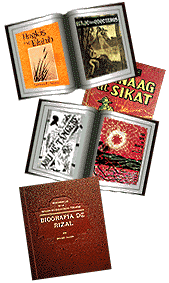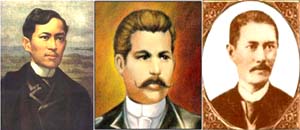The Philippines is an island country in Southeast Asia bordering the Philippine Sea, the South China Sea, the Sulu Sea, and the Celebes Sea. People from the Philippines speak a language that formed within the island group known as Tagalog, although from the early 1500s the islands were a Spanish colony, and in the first half of the 20th century the islands were controlled by the United States of America. The Philippines is the 11th most populous country in the world.
In common with other aboriginal societies the Philippine islands have a rich oral history of legends, fables, and poetry that dates from antiquity, although sadly much has been forgotten amongst urban dwellers and is in most cases only retained by older generations who are the subject of a frantic project by universities and cultural awareness groups to put into writing or other recorded media their memories and stories told to them by their own parents and grand-parents.
Being of Austronesian origins many of the ancient literature of the Philippines stems from ancestral worship and legends brought with the first settlers from Taiwan, the first homeland of the Austronesian people. These ancient stories about the gods and heroes are shared in the most part with stories that are common to people from the pacific islands, New Zealand, Indonesia, and Madagascar however the Philippine islands have been settled for much longer allowing home-grown versions to develop. A favorite fable with Philippine children is the story of the Monkey and the Turtle.

“A monkey and a turtle were good friends and lived close by to each other. One day the turtle suggested he and the monkey should go for a walk, and a little while later they happened across a banana plant. Deciding to keep the plant they cut it into two pieces and planted them in their gardens, but the monkey’s piece was from the bottom of the plant and didn’t grow. Turtle had more luck with the top of the plant which grew straight and strong. A few weeks later the turtle went to visit the monkey, and seeing him looking sad asked why. After the monkey had explained his loss the turtle suggested the monkey help him pick the fruit of his own banana plant.
The monkey readily agreed but on reaching the fruit at the top of the tree proceeded to eat it all. Turtle pleaded with his friend for some of the fruit but the monkey only threw the empty peel to turtle. Wanting to teach his friend a lesson the turtle placed large thorns around the base of the tree and bid his friend goodnight. When monkey descended to go home his belly was too full and he fell directly onto the thorns. Angry at this the monkey set out the following morning to find the turtle and punish him.

Near the river monkey found the turtle and holding him the air told turtle he was to be roasted over the fire and made into turtle soup. The turtle being cunning agreed that this was a fitting punishment, and was much preferable to being thrown in the river. The monkey sensing a worse punishment for the turtle immediately threw him into the river not knowing that turtles are good swimmers. A while later the turtle surfaced holding a large fish in his jaws and exclaiming at how wonderful the taste was. The monkey asked his friend to share the fish with him but turtle retorted instead that the monkey was just too lazy to get his own. Not to be outdone the monkey jumped into the river and drowned.”
The moral of the story is that one should always share everything with one’s friends, a defining nature of Filipino people.
Written literature existed prior to the beginning of the Spanish colonial period however Spain was in the grip of the inquisition and church doctrine decreed that existing Philippine written records be destroyed, including the uniquely Philippine alphabet, all of which was to be replaced by Catholic teachings in Spanish only. The passion of Christ was forced on indigenous communities and those who were to become part of the colonial ruling elite were taught latin script.
The only surviving documents written in the ancient Tagalog alphabet, known as Baybayin are not works of literature, for example the Lagune Copperplate Inscription from 900AD which is a receipt for payment of a debt, and the Doctrina Christiana of 1593. In fact literature in the Philippines in written form is only known from times well into the colonial period. Many of the works written in the early colonial period were religious in nature extolling the virtues of Christianity to a population that had previously followed local polytheism.
Chants and poems that could be read or memorized for use in church or in local festivities were actively encouraged, the “Memorial de la vida cristiana en lengua tagala” by Fernando Bagonbanta in 1605 contained many lyrics that could be sung. In 1640 an ancient epic, Biag ni Lam-ang was published by Pedro Buceneg, a blind Filipino poet who related the ancient fable to a monk from his local parish. 1705 saw Gaspar Aquino de Belen write a series of quintillas that were more subdued and serious in nature than those of his predecessor Bagonbanta, emphasizing the solemnity of the life of Christ. These are still in use in the Philippines today.
Until this time, and thru the first half of the 20th century most Philippine poetry and literature was written in Spanish, Tagalog being frowned upon as a base language not worthy of great works of writing. One of the Philippines greatest writers of any era francisco Balagtas, a man likened with William Shakespeare for the prolific and profound nature of his works, refused to write in Spanish for which he was persecuted during his lifetime. His greatest work, Florante at Laura, also written in Tagalog tells the story of a man and a woman in the time of the Greek Empire.
The Philippine national hero, José Rizal is considered the father of indigenous Philippine literature even though his works were written and published in Spanish. He was also the first to look outside of church doctrine for his inspiration, although his works “Noli me Tangere”, and “El filibusterismo” published in 1887 and 1891 respectively do deal with the corruption of the priests and lack of equality of Philippine people. José Rizal wasn’t just a revolutionary, he was also a very intelligent man who considered Philippine independence to be essential for the survival of the Tagalog language and the continuing development of the islands which he considered were being systemically mismanaged at the expense of the majority Tagalogs who were considered second class citizens.
Jozé Rizal thru his life inspired a great many Filipinos not just in literature, but also as a model for civilized living. Rizal himself had studied Medicine and Philosophy earning multiple degrees from several European universities. He also spoke at least 22 languages. Sadly his works of literature were limited to just two novels, the second of which is a sequel owing to his execution by firing squad in 1896 at the age of 35 after being convicted of fermenting revolutionary ideas.

Following Rizal’s death the Philippines came under US control, initially as a colony and then later as a Commonwealth associated with the US, a period that saw the revolutionary struggle continue unabated. Spanish became the chosen language of early 20th century writers and poets as a simple act of defiance against the US, with notable authors such as Epifanio de los Reyes, Claro Recto, Vicente Sotto, Teodoro Kalaw amongst them.
By the beginning of World War 2 English had become the preferred language of literature. The Japanese invasion and occupation saw a brief flirtation with writing in Tagalog since Japanese forces were suspicious that Philippine spies would use English to pass secret messages to US forces. Whilst writing in Tagalog has always been considered true Philippine literature and poetry it has always been seen as somehow local, and not intended for foreign audiences.
By way of contrast, writing in English has allowed Philippine authors to expand their horizons and have their writing published in a global market, in which many have excelled, to the extent that short story writing and poetry is a major cultural export from the Philippines. Whilst professional writing in the Philippines is nowhere near as advanced as other English speaking nations, several awards are offered annually that recognize excellence, including the Republic Cultural Heritage Awards, the Pro Patris Awards for Literature, and the National Artist Awards.
Contemporary and late 20th century writers who have gained critical acclaim include Resil Mojares, Alfred Yuson, Jose Dalisay, Ian Casocot, Cirilo Bautista, Marjorie Evasco.